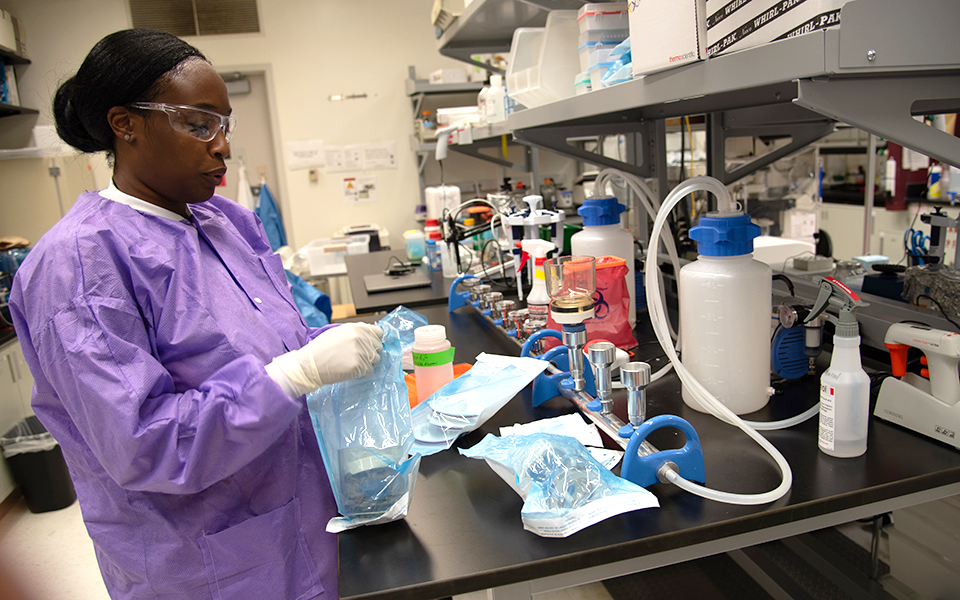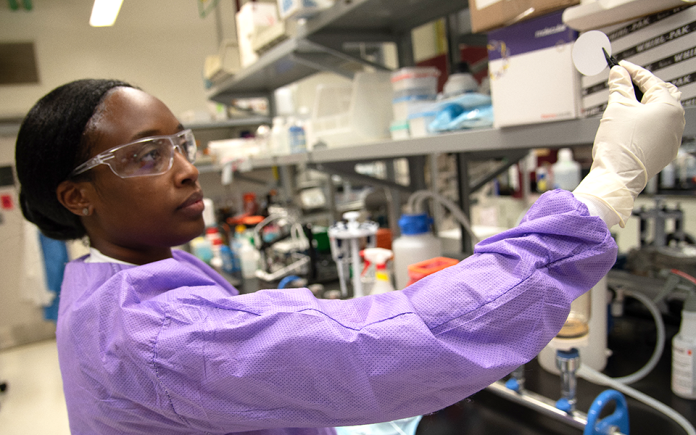NIST researcher Alshae’ Logan-Jackson looks at concentrated cells on a pore-sized membrane. This is part of the wastewater sample processing that allows microorganisms to be analyzed downstream in the wastewater surveillance testing methods.
Credit:
B. Hayes/NIST
I grew up in a small town with limited medical resources, and I have a brother who is immunocompromised. My brother’s condition impacts his daily life, which has been stressful for my family and me.
I was determined to have a graduate career in science. Because my biggest motivation is family, I wanted to work in a field that was directly related to helping people like my brother who have immunocompromising and other health conditions.
After I earned my Ph.D., I came to NIST and started studying microbial water quality, specifically as it relates to residential plumbing.
You may wonder what plumbing has to do with health and immunocompromising conditions.
Pathogens can get into our water through plumbing. They are known as opportunistic premise plumbing pathogens. When a plumbing system condition allows bacteria to grow to a dangerously high level, it can lead to pneumonia and other health conditions. This is especially dangerous for people with compromised immune systems, such as those with diabetes and cancer, as well as people who smoke.
I studied water temperature and water use in homes in a laboratory house on NIST’s campus in Gaithersburg, Maryland. The purpose of the study was to make a connection between these factors and dangerous bacteria. Our study suggested that higher water usage overall and using water at a higher temperature led to fewer pathogens in the plumbing.
Our results fit with the existing scientific understanding that unused water in buildings may lead to a buildup of plumbing pathogens, although this needs to be studied further in more types of residential buildings.
NIST Takes First Steps Toward Improved Water Quality
Waterborne microorganisms known as opportunistic premise plumbing pathogens (OPPPs) are regular denizens of plumbing systems and can infect vulnerable populations, such as the elderly or immunocompromised. Water temperature and usage may influence and potentially stifle the growth of OPPPs. Using NIST’s Net-Zero Energy Residential Test Facility as a model system, NIST researchers measured OPPP levels under varying conditions to learn more.
Setting the Standard for Wastewater Surveillance
My area of expertise is also relevant to something that has been in the news since the onset of COVID-19 — wastewater surveillance. Wastewater surveillance is simply testing an area’s wastewater to estimate the levels of infection in a community. You may have just heard about it during COVID-19, but it’s been used for decades to track polio and other viruses.
It’s not practical to test every person in a city or state for a virus. That’s why wastewater testing is useful. It can give scientists and local officials an idea of what viruses are circulating in the community and allow leaders to plan accordingly.
One of the challenges with wastewater surveillance is that communities and states take their own approaches. We need to be able to compare data across jurisdictions to better understand infection levels.
We can’t compare data among different states if each state tests differently. Even within a state, testing approaches and methodologies often vary. We also want to make sure scientists can document their results. Other scientists should be able to follow the documentation and reproduce the results. To do this, we need consistency in approaches across labs.
I’m co-leading the development of a best practice document that will offer optional guidance to health departments and other laboratories on the many different approaches used for concentrating wastewater samples for testing.
For example, some laboratories use a process that concentrates wastewater samples using a pore-filled membrane so the microorganisms can be analyzed.
Our document will offer best practices on how to use this method successfully. Even seemingly mundane suggestions, such as remembering to change your gloves between each sample, so there’s no carryover contamination, make a difference in data quality.
If states and communities adopt it, we’ll have a better understanding of the national picture of viral conditions, such as polio and flu, because we’ll be able to compare data across the country.

Alshae’ Logan-Jackson works in her lab at NIST’s campus in Gaithersburg, Maryland. Logan-Jackson’s research involves both wastewater testing for viruses and microbial water quality, as it relates to residential plumbing.
Credit:
B. Hayes/NIST
One of the most important ways to ensure high-quality testing of wastewater is to validate our testing methodologies. When you take a sample of wastewater, you don’t yet know how much virus is in that sample. How do you know if your test results will give you the best possible information?
Here’s one approach. Scientists take a substance that is not found in wastewater naturally — such as a type of cattle vaccine — and inject a known amount into the wastewater sample they are testing in the lab. They then run their tests and track how much vaccine is lost over the course of the tests. The vaccine injected in the water serves as the stand-in for the pathogen that will later be tested using the same methodology.
The goal is to lose as little of the vaccine as possible because you want to ensure that your method is processing the sample properly and maintaining the amount of virus in the sample for later measurements. Scientists can then repeat this same process for a virus in a sample of wastewater, and ideally, they will get similar amounts of the virus in the test.
By testing our practices this way, we can validate our methodologies to ensure we have the best possible data.
The Evolving Field of Wastewater Research
This field will continue to develop in the coming years. I’m excited to keep researching all things related to health and water. One of the key factors for advancing this science is data, and I’m hoping the standards we are creating here will lead to better data for researchers.
I hope in the future not only that we will have a best practice standard for testing wastewater, but also that we can tailor testing to specific viruses we’re searching for. We may find better ways to test for certain viruses than others.
It’s very gratifying to be able to help people stay healthy — whether it’s monitoring the water we drink or keeping an eye on bacteria in our wastewater.
This work is very meaningful, and I’m aware of the impact I’m having on communities across the country, especially for people with immunocompromising conditions.
www.nist.gov
https://www.nist.gov/blogs/taking-measure/protecting-people-plumbing-pathogens-personal-me














